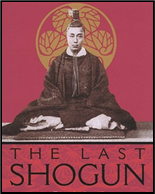 xxxxxAs we have seen, it was in 1868
(Vb), that the shogunate system of
government in Japan - based upon the rule of hereditary
feudal lords - was finally overthrown and imperial power was
restored. In the Boshin War of that year, the army of the last
shogun, Yoshinobu (illustrated), proved no match for the Emperor’s forces, and the
rule of the shoguns - dating from 1192
(R1) - was brought to an end. Power
then resided in Emperor Mutsuhito, a boy of fifteen years. He took
the title Meiji (meaning “enlightened
government”) and, advised by court officials, embarked upon a rapid
programme of modernisation aimed at combining “western advances”
with “traditional eastern values”. Feudalism was abolished in a bid
to make Japan a world power.
xxxxxAs we have seen, it was in 1868
(Vb), that the shogunate system of
government in Japan - based upon the rule of hereditary
feudal lords - was finally overthrown and imperial power was
restored. In the Boshin War of that year, the army of the last
shogun, Yoshinobu (illustrated), proved no match for the Emperor’s forces, and the
rule of the shoguns - dating from 1192
(R1) - was brought to an end. Power
then resided in Emperor Mutsuhito, a boy of fifteen years. He took
the title Meiji (meaning “enlightened
government”) and, advised by court officials, embarked upon a rapid
programme of modernisation aimed at combining “western advances”
with “traditional eastern values”. Feudalism was abolished in a bid
to make Japan a world power.
xxxxxUnder
the so-called Meiji Restoration there was a
measure of political reform. Political parties were permitted,
and, based on the British model, a House of Representatives and a
House of Lords were established in 1889, but the franchise was
severely limited, and the emperor’s powers were stringently
safeguarded. Sovereignty remained firmly in his hands. On the
industrial front, however, there was no such limitation. After
sending out delegates and students to learn from the Western
nations, industrialisation developed at a formidable pace, feeding
above all the needs of both the navy and the army. Nationwide
conscription was introduced in 1872, and the armed forces were
trained in Western tactics and weaponry.
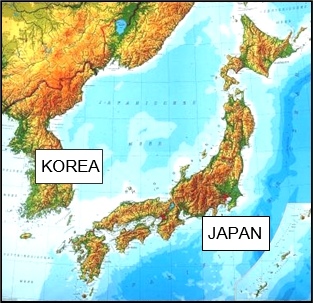 xxxxxThis new-found strength enabled Japan to embark
on an aggressive foreign policy, aimed at strengthening the
nation’s defences. As early as 1879, for example, the Ryukyu
Islands, lying to the south and under Japanese protection since
1609 - were officially taken over. Butxthe
real threat to the country’s security lay to the west, where the peninsular of Korea -
in the words of one military observer - was “a dagger pointed
at the heart of Japan”. For centuries Korea had been a member of
the Chinese tributary system. In return for recognising the
superiority of the Chinese emperor and giving regular gifts to the
Chinese court, the country had enjoyed a large measure of
independence. Having survived invasions by the Japanese at the end
of the 16th century, and by Manchuria early in the next century,
the country remained comparatively peaceful and isolated for some
250 years. Western visitors dubbed it “the hermit kingdom”. By the
late 19th century, however, a number of countries were taking an
interest in the peninsular, both for its strategic position and
its mineral wealth. Japan feared that whoever took a firm control
of the country would pose a serious threat to national security.
xxxxxThis new-found strength enabled Japan to embark
on an aggressive foreign policy, aimed at strengthening the
nation’s defences. As early as 1879, for example, the Ryukyu
Islands, lying to the south and under Japanese protection since
1609 - were officially taken over. Butxthe
real threat to the country’s security lay to the west, where the peninsular of Korea -
in the words of one military observer - was “a dagger pointed
at the heart of Japan”. For centuries Korea had been a member of
the Chinese tributary system. In return for recognising the
superiority of the Chinese emperor and giving regular gifts to the
Chinese court, the country had enjoyed a large measure of
independence. Having survived invasions by the Japanese at the end
of the 16th century, and by Manchuria early in the next century,
the country remained comparatively peaceful and isolated for some
250 years. Western visitors dubbed it “the hermit kingdom”. By the
late 19th century, however, a number of countries were taking an
interest in the peninsular, both for its strategic position and
its mineral wealth. Japan feared that whoever took a firm control
of the country would pose a serious threat to national security.
xxxxxIn this
connection, the country most feared at this stage was Russia.
China did have something of a hold on the country but, as we have
seen, the Chinese Empire was in decline. The two Opium Wars of 1839 (Va) and 1856 (Va), had resulted in
the establishment of foreign enclaves in all the country’s major
ports, and a string of “unequal treaties” which had given Western
powers political as well as commercial rights. An attempt was made
to learn from the (Western) “barbarians” in order to take control
of them - the so-called “Self-Strengthening
Movement”, initiated in 1861 - but due to divisions at Court
it proved totally inadequate. Given the inherent weakness of the
Chinese Empire, Japan saw the need to seize control of Korea
before it fell into the hands of Russia or, indeed, one of the
other Western powers.
xxxxxThexfirst step was taken in February 1876 when, employing
gun boat diplomacy, Japan forced the Treaty
of Ganghwa upon Korea. By this so-called
“Treaty of Friendship”, three Korean ports were opened to Japanese
trade, and Japanese merchants - subject only to Japanese law
- were granted unrestricted freedom throughout the country.
Korea was declared a free nation - a measure which ostensibly
freed it from its tributary relationship with China - but
Japan clearly gained a large measure of influence within the
country, paving the way for further penetration. Not surprisingly,
the terms of the treaty only served to embitter relations between
China and Japan, and in 1884 there was a clash of arms in the
capital Seoul during which a Japanese attempt to take over the
government was overthrown by the arrival of a large Chinese force.
This incident led to the Sino-Japanese Convention of Tientsin
of April 1885 by which both powers agreed to withdraw their troops
from Korea.
xxxxxThexfinal showdown came in 1894
with the Donghak Rebellion, a peasant uprising aimed at the overthrow of the
Korean government and the expulsion of foreigners. It was the
opportunity Japan had been waiting for. Under the Tientsin
agreement both countries sent troops, but the Japanese contingent,
some 8,000 strong, seized the emperor, occupied the royal palace
in Seoul, and set about expelling the Chinese troops. The war
between Qing China and Meiji Japan, long in the making, was
finally under way.
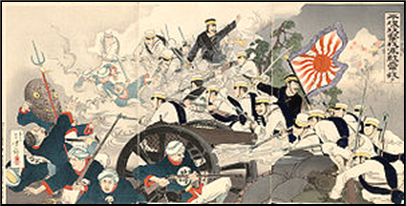 xxxxxThe conflict was brief
and decisive. On paper the Chinese had a large army, and its navy
- which included two ironclad battleships and four armoured
cruisers - was regarded as the most powerful in Asia.
However, there was a great deal of corruption within the armed
forces, morale was low, and equipment was poorly maintained. On
the other hand, via the Meiji Restoration, the Japanese army and
navy had been modernised on Western lines and were fully prepared
for combat. Asxa result, in July China’s
Beiyang Army was defeated at the minor Battle of Seonghwan, near
the port city of Asan, and then, despite an advantage in numbers,
overpowered at the Battle of Pyongyang (illustrated) in the September. Japanese imperial troops, advanced
on the city of Pyongyang from several directions and, breaking
through the defences, inflicted heavy casualties. Following this
defeat, the Chinese abandoned northern Korea and took up defensive
positions along the Yalu River, close to Jiuliancheng on the
Manchurian border. Japanese troops followed in pursuit and reached
the area towards the end of October.
xxxxxThe conflict was brief
and decisive. On paper the Chinese had a large army, and its navy
- which included two ironclad battleships and four armoured
cruisers - was regarded as the most powerful in Asia.
However, there was a great deal of corruption within the armed
forces, morale was low, and equipment was poorly maintained. On
the other hand, via the Meiji Restoration, the Japanese army and
navy had been modernised on Western lines and were fully prepared
for combat. Asxa result, in July China’s
Beiyang Army was defeated at the minor Battle of Seonghwan, near
the port city of Asan, and then, despite an advantage in numbers,
overpowered at the Battle of Pyongyang (illustrated) in the September. Japanese imperial troops, advanced
on the city of Pyongyang from several directions and, breaking
through the defences, inflicted heavy casualties. Following this
defeat, the Chinese abandoned northern Korea and took up defensive
positions along the Yalu River, close to Jiuliancheng on the
Manchurian border. Japanese troops followed in pursuit and reached
the area towards the end of October.
xxxxxMeanwhile,
in the largest encounter at sea, - the Battle
of the Yalu River in September 1894 -
the Chinese navy fared no better than their ground forces.
Regarded as one of the first naval battles of modern times,
involving as it did ironclads, rapid firing guns and the use of
torpedoes, the Japanese imperial navy, modelled on the British
Royal Navy, faced no serious opposition. In a day-long battle
fought off the mouth of the river, it sank five Chinese warships
and badly damaged three others, including the two ironclad
battleships. Four Japanese ships were seriously damaged but none
was sunk. What remained of the Chinese fleet made for the safety
of Port Arthur, and then retreated to the naval base of Weihaiwei
across the Bohai Strait.
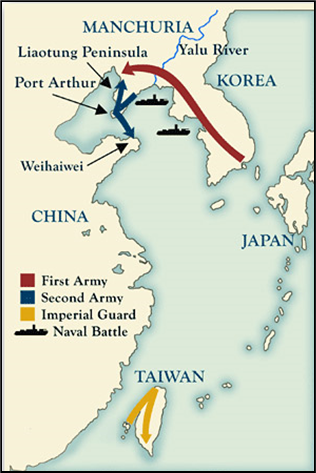 xxxxxThe Manchurian campaign again showed the superiority
of the Japanese land forces. Having reached the Yalu River at the
end of October, a crossing was made by the building of a pontoon
bridge, and, following the capture of Jiuliancheng, the Chinese
forces were put to flight. The Japanese then advanced on two
fronts (see map).
The First army
made for the city of Mukden whilst the Second army moved
westward along the Liaodong Peninsular, capturing a number of towns
including the walled-town of Hai Cheng. Inxthe meanwhile a Japanese force was landed on the
southern coast of the peninsula and advanced towards Port Arthur.
Having seized the city on the 21st November, the Japanese then
launched an attack upon Weihaiwei. The siege of this naval base lasted 23 days and
proved the decisive battle of the war. Fought in severe winter
conditions over January and February of 1895, the Japanese
eventually captured the well-fortified town in a nine-hour
battle. A few days later the Japanese navy, made up of 25 warships
and 16 torpedo boats, attacked the Chinese fleet of 15 warships -
including the two ironclad warships that had survived the Battle
of the Yalu River - and 13 torpedo boats. A series of day and
night attacks were made over a period of five days, by the end of
which the entire Chinese fleet had been destroyed or captured.
Such was the scale of the Japanese victory that, following the
formal surrender, the commander and deputy commander of the
Chinese fleet, and the general in charge of the coastal forts
committed suicide.
xxxxxThe Manchurian campaign again showed the superiority
of the Japanese land forces. Having reached the Yalu River at the
end of October, a crossing was made by the building of a pontoon
bridge, and, following the capture of Jiuliancheng, the Chinese
forces were put to flight. The Japanese then advanced on two
fronts (see map).
The First army
made for the city of Mukden whilst the Second army moved
westward along the Liaodong Peninsular, capturing a number of towns
including the walled-town of Hai Cheng. Inxthe meanwhile a Japanese force was landed on the
southern coast of the peninsula and advanced towards Port Arthur.
Having seized the city on the 21st November, the Japanese then
launched an attack upon Weihaiwei. The siege of this naval base lasted 23 days and
proved the decisive battle of the war. Fought in severe winter
conditions over January and February of 1895, the Japanese
eventually captured the well-fortified town in a nine-hour
battle. A few days later the Japanese navy, made up of 25 warships
and 16 torpedo boats, attacked the Chinese fleet of 15 warships -
including the two ironclad warships that had survived the Battle
of the Yalu River - and 13 torpedo boats. A series of day and
night attacks were made over a period of five days, by the end of
which the entire Chinese fleet had been destroyed or captured.
Such was the scale of the Japanese victory that, following the
formal surrender, the commander and deputy commander of the
Chinese fleet, and the general in charge of the coastal forts
committed suicide.
xxxxxAfter the
fall of Weihaiwei, Japanese forces advanced further into southern
Manchuria. Having repulsed a Chinese attempt to recapture Hai
Cheng, they attacked the port of Yingkou (also known as Newchwang)
and, having taken the city after fierce street fighting, bombarded
the Town of Tianzhuangtai on the other side of the Liao River,
razing it to the ground. By then, however, the war was coming to
an end. The Japanese were preparing for a two-pronged attack
upon the capital of Beijing, and the Chinese were ready to sue for
peace. With this in mind, towards the end of March the Japanese Imperial Guard seized the
Pescadores Islands off the west coast of Taiwan. After a naval
bombardment of the Chinese forts, the troops landed and, meeting
little resistance, had secured the islands within three days.
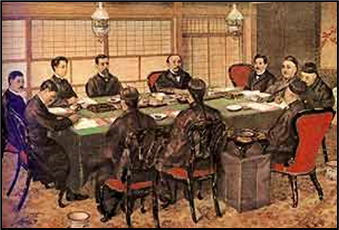 xxxxxThe Treaty of Shimonoseki (illustrated), signed in April 1895, recognised the “full and
complete” independence of Korea (though it now came firmly under
Japanese control), and ceded to the Japanese the Island of Taiwan
and the Pescadores Islands. In addition, China was obliged to pay a
large indemnity, recognise Japan as its most favoured trading
nation, and open up the ports of Shashi, Chungking, Suchow and
Hangchow to Japanese trade. Initially, Japan was also awarded the
Liaodong Peninsular in southern Manchuria, but after the signing of
the treaty three nations - Russia, France and Germany -
united to oppose this settlement and forced Japan to accept an
additional indemnity instead. As was to be expected, shortly
afterwards Russia occupied Liaodong Peninsula, including the ice-free
port of Port Arthur, and in 1897, following the murder of two German
missionaries, German troops seized Kiaochow Bay - an inlet of
the Yellow Sea in Shantung province - and eventually gained a
99 year lease of the area. France and Great Britain were not far
behind. France acquired Kwang-Chou Wan, an enclave on the
southern coast of China, in May 1898, and in the same year Great
Britain set up a naval station at Weihaiwei as a counterbalance to
the Russian presence at Port Arthur. It was the fear of such
intervention by the Western powers that had prompted Japan to pick a
war with China and seize control of Korea.
xxxxxThe Treaty of Shimonoseki (illustrated), signed in April 1895, recognised the “full and
complete” independence of Korea (though it now came firmly under
Japanese control), and ceded to the Japanese the Island of Taiwan
and the Pescadores Islands. In addition, China was obliged to pay a
large indemnity, recognise Japan as its most favoured trading
nation, and open up the ports of Shashi, Chungking, Suchow and
Hangchow to Japanese trade. Initially, Japan was also awarded the
Liaodong Peninsular in southern Manchuria, but after the signing of
the treaty three nations - Russia, France and Germany -
united to oppose this settlement and forced Japan to accept an
additional indemnity instead. As was to be expected, shortly
afterwards Russia occupied Liaodong Peninsula, including the ice-free
port of Port Arthur, and in 1897, following the murder of two German
missionaries, German troops seized Kiaochow Bay - an inlet of
the Yellow Sea in Shantung province - and eventually gained a
99 year lease of the area. France and Great Britain were not far
behind. France acquired Kwang-Chou Wan, an enclave on the
southern coast of China, in May 1898, and in the same year Great
Britain set up a naval station at Weihaiwei as a counterbalance to
the Russian presence at Port Arthur. It was the fear of such
intervention by the Western powers that had prompted Japan to pick a
war with China and seize control of Korea.
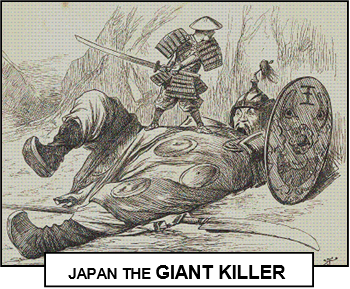 xxxxxThe decisive victory achieved by the Japanese -
based upon their rapid programme of modernisation and
industrialisation - established Japan as a rising world
power, a status fully confirmed some ten years later following the
country’s remarkable victory in the Russo-Japanese War of
1904-5, fought over Russia’s occupation of Manchuria and threat towards Korea. Meanwhile,
the humiliating defeat suffered by the Chinese, following on from
their failure in the Sino-French War of 1884-5, only
served to increase xenophobia within the country. As we shall see,
this led to the Boxer Rebellion of 1900, further exploitation by the Western powers, and the
eventual fall of the Qing dynasty in 1911.
xxxxxThe decisive victory achieved by the Japanese -
based upon their rapid programme of modernisation and
industrialisation - established Japan as a rising world
power, a status fully confirmed some ten years later following the
country’s remarkable victory in the Russo-Japanese War of
1904-5, fought over Russia’s occupation of Manchuria and threat towards Korea. Meanwhile,
the humiliating defeat suffered by the Chinese, following on from
their failure in the Sino-French War of 1884-5, only
served to increase xenophobia within the country. As we shall see,
this led to the Boxer Rebellion of 1900, further exploitation by the Western powers, and the
eventual fall of the Qing dynasty in 1911.
xxxxxIncidentally, when the Japanese seized the city of Port Arthur in
November 1894 they claimed to have found the mutilated remains of
Japanese prisoners. As a reprisal there followed what has come to
be known as the Port Arthur Massacre during which almost the entire Chinese population of
the city was slaughtered. This was a ruthless conflict throughout.
Most prisoners were publicly executed, and atrocities were
committed by both sides. ……
xxxxx…… It is estimated that the number of Japanese killed
during the war varied from 800 to 14,000, and that more were
killed by cholera than in battle. Chinese losses are put at 35,000
killed or wounded. ……
xxxxx…… The Treaty of Ganghwa of 1876 by which the Japanese
forced Korea to open up a number of ports for trade, was very
reminiscent of the Treaty of Kanagawa twenty-two years
earlier when, as we have seen, a fleet of ships led by the
American Commodore Matthew Perry forced the shogunate to accept a
similar trade agreement - the first of a number of “unequal
treaties”. ……
xxxxx…… The Second Sino-Japanese War began in 1937
following the Japanese occupation of Manchuria, and ended in 1945
with the defeat of Japan in the Second World War.



 xxxxxAs we have seen, it was in 1868
(Vb), that the shogunate system of
government in Japan -
xxxxxAs we have seen, it was in 1868
(Vb), that the shogunate system of
government in Japan - xxxxxThis new-
xxxxxThis new- xxxxxThe conflict was brief
and decisive. On paper the Chinese had a large army, and its navy
-
xxxxxThe conflict was brief
and decisive. On paper the Chinese had a large army, and its navy
- xxxxxThe Manchurian campaign again showed the superiority
of the Japanese land forces. Having reached the Yalu River at the
end of October, a crossing was made by the building of a pontoon
bridge, and, following the capture of Jiuliancheng, the Chinese
forces were put to flight. The Japanese then advanced on two
fronts (see map).
The First army
made for the city of Mukden whilst the Second army moved
westward along the Liaodong Peninsular, capturing a number of towns
including the walled-
xxxxxThe Manchurian campaign again showed the superiority
of the Japanese land forces. Having reached the Yalu River at the
end of October, a crossing was made by the building of a pontoon
bridge, and, following the capture of Jiuliancheng, the Chinese
forces were put to flight. The Japanese then advanced on two
fronts (see map).
The First army
made for the city of Mukden whilst the Second army moved
westward along the Liaodong Peninsular, capturing a number of towns
including the walled- xxxxxThe Treaty of Shimonoseki (illustrated), signed in April 1895, recognised the “full and
complete” independence of Korea (though it now came firmly under
Japanese control), and ceded to the Japanese the Island of Taiwan
and the Pescadores Islands. In addition, China was obliged to pay a
large indemnity, recognise Japan as its most favoured trading
nation, and open up the ports of Shashi, Chungking, Suchow and
Hangchow to Japanese trade. Initially, Japan was also awarded the
Liaodong Peninsular in southern Manchuria, but after the signing of
the treaty three nations -
xxxxxThe Treaty of Shimonoseki (illustrated), signed in April 1895, recognised the “full and
complete” independence of Korea (though it now came firmly under
Japanese control), and ceded to the Japanese the Island of Taiwan
and the Pescadores Islands. In addition, China was obliged to pay a
large indemnity, recognise Japan as its most favoured trading
nation, and open up the ports of Shashi, Chungking, Suchow and
Hangchow to Japanese trade. Initially, Japan was also awarded the
Liaodong Peninsular in southern Manchuria, but after the signing of
the treaty three nations - xxxxxThe decisive victory achieved by the Japanese -
xxxxxThe decisive victory achieved by the Japanese -


